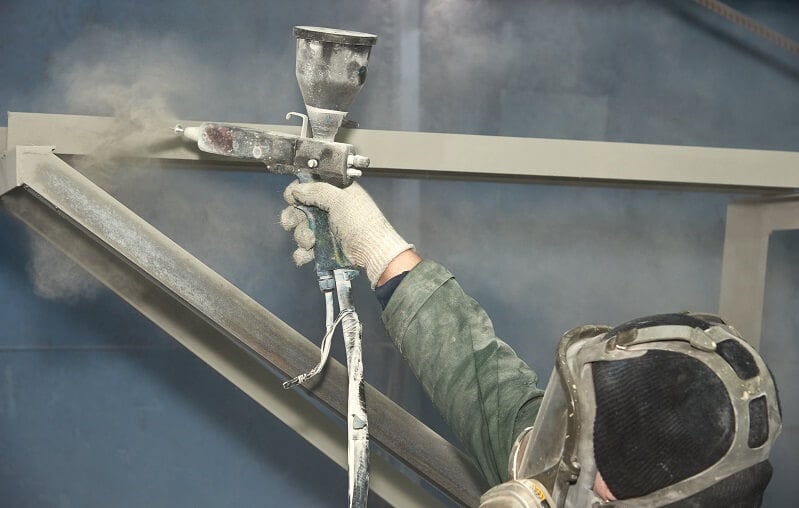
On This Page:
- What is Powder Coat Finish?
- What is Powder Coat Paint Made Of?
- What is Electrostatic Powder Coating?
- What is the Fluidized Bed Method?
- What Can Be Powder Coated?
- Powder Coat Steel, Cast Aluminum & Metal Painting Process
- Powder Coat Spray Guns & Other Equipment
- Advantages
- FAQs
- DIY vs. Hiring a Pro
Powder Coating Basics
Powder coating is something you’ve probably seen hundreds of times – on cars, motorcycles, handrails and even light fixtures. Used extensively in both commercial and residential applications, this incredibly durable finishing technique creates a beautiful and customized look that protects for years with no upkeep.
This guide covers everything you need to know about what it is, how it works, what you’d use it on, why you’d want it and how to get it.
What is a Powder Coat Finish?
Powder coating, not to be confused with electrostatic painting, uses a process of electrostatically charged or fluidized applications of a dry powder. Once applied, it’s baked in an oven above 385 degrees Fahrenheit to set, bond and cure the coat.
What is Powder Coat Paint Made Of?
There are slight variations on different products, but they are all very similar. Ingredients include:
- Resin – usually epoxy or polyester.
- Curing Agent – helps during the curing process.
- Additives – there for many purposes from creating a glossy finish to adding textures and the overall hardness.
- Tints – bring the color to the coating.
- Extenders or Fillers – usually provide extra durability.
What is Electrostatic Powder Coating?
Electrostatic powder coating uses an electrostatic charge and low-pressure gun to distribute the dusted material over a metal part. It’s then baked to set it and give it a hardened and smooth finish.
What is the Fluidized Bed Method?
Instead of using a low-pressure gun to charge and spray, it instead uses a vat. Air forced through the powder in the vat makes it act like a liquid. The article getting covered is then preheated and dipped into the bed. The thickness of the coat depends on how long you leave the part submerged. It’s then baked in an oven to set and cure the finish.
Ready to start your Powder Coating Project?
Find ProsReturn to Top
What Can Be Powder Coated?
Anything that can withstand temperatures above 385 degrees Fahrenheit can be powder coated. This includes all alloys and heat-resistant plastics. Since plastics don’t conduct electricity, they can only use the dipping method.
Why Powder Coat Your Appliances?
Powder coating your appliances has three main benefits and only one real drawback – cost.
- It unifies and renews the look of older, worn pieces.
- It lets you colorize your kitchen.
- It creates a hardened surface great for protection in a high-use environment.
Powder Coated Metal
Many parts, toys, and equipment come already powder coated. Examples of these items include motorcycle frames, tools, machinery and some automotive parts like a trailer hitch. Typically, this increases the cost but provides a higher-quality item.
You can use this process with anything that withstands high temperatures. Most commonly, you’ll find cast iron, aluminum, and steel. You’ll only want to apply this to rigid pieces as it’s an inflexible finish. Aluminum requires extra prep work that we’ll go into below.
Plastic Power Coating
Plastic powder coating uses the fluidized bed method because it’s nonconductive. However, it must handle the high temperatures of a curing oven. Only available for high-temp plastics.
For a full comparison of traditional spray painting vs. powder coating, check out our guide.
Powder Coat Metal Painting Process
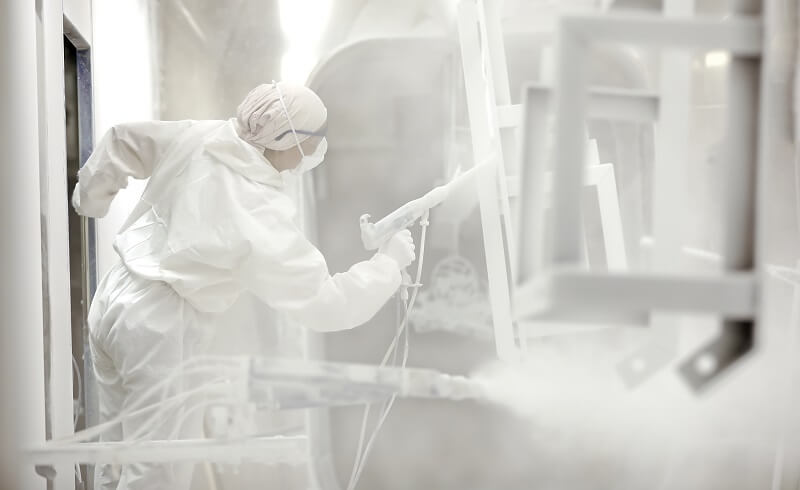
You can cover most alloys without much problem, though some do better than others. Some require special treatments while others need minimal prep.
The process follows the same steps regardless of the substrate.
- Surface prep. This is the most critical step. Depending on the substrate, this step involves mechanical and chemical preparations. Typically, blasting with sand, glass beads or shells removes any existing coatings. Chemicals remove oxide layers, oil, grease, and dirt.
- This is key to proper adhesion. Removing oil, dirt, grease and any other debris allows it to adhere evenly to the substrate. Without proper cleaning, the covering will fail quickly and chip away easily.
- Coating Application. This step uses either an electrostatic gun or fluidized vat dipping.
- Oven Baking. Finally, the part is placed in an oven to bake. This sets and cures the finish. Improper baking time or temps can cause premature finish failure – cracking and chipping.
Powder Coated Steel & Aluminum Prep
Both steel and aluminum use this process to protect it from corrosion and give it a durable finish.
However, there are many subtypes of metal that require specific prep and benefit from different types of finish.
- Cast Aluminum – Requires removal of the oxide layer by chemical treatment. Without removal, the finish won’t adhere properly. Typically, you’ll want an epoxy type, though polyester or epoxy-polyester work too.
- Anodized Aluminum – Doesn’t require as much cleaning and setup as cast, but some anodized finish types won’t work well with powder. Your professional can do a wet adhesion test to see if covering it is possible. Similar to cast aluminum.
- Carbon Steel – This basic steel corrodes easily. Use sand/shell/bead blasting for prep. Mainly use epoxy for durability and corrosion resistance.
- Stainless Steel – No corrosion issues and easy to prep with sandblasting. Mainly use polyester though any type works.
- Galvanized Steel – Galvanization stops corrosion, so only requires minimal sandblasting.
Removing Electrostatic Coating
There are three ways to remove this durable finish, but none are easy.
- Chemicals strip it off using hazardous liquids. Typically used in commercial shops with a high volume of products, the proper equipment, and disposal methods. This is the most dangerous removal process both to the user and the environment.
- Heat it to burn off the coating works. However, this requires temperatures up to 1,000 degrees Fahrenheit or higher and takes up to 6 hours.
Sandblasting is the easiest and cheapest operation. The article is put into a sandblasting cabinet and hit with sand, shells or other material to mechanically strip the coating off.
Ready to start your Powder Coating Project?
Find ProsReturn to Top
Advantages & Disadvantages of Powder Coat Painting
|
Pros |
Cons |
|---|---|
|
Extremely durable |
Thick finish |
|
Low waste |
Hard to color match |
|
Low environmental impact |
Can’t touch up |
|
Less expensive long-term |
Only available for high-temp capable items |
Known for its extreme durability and protective qualities, it is also a low waste, environmentally responsible method of protection. Reusing excess powder creates almost zero waste, and the entire process releases virtually no volatile organic chemicals (VOCs).
However, it’s only available for components that can withstand oven temperatures that near or exceed 400 degrees Fahrenheit. This eliminates many plastics. It’s also tough to color match existing items. Once done, it can’t be touched up like paint.
Ready to start your Powder Coating Project?
Find ProsReturn to Top
FAQ
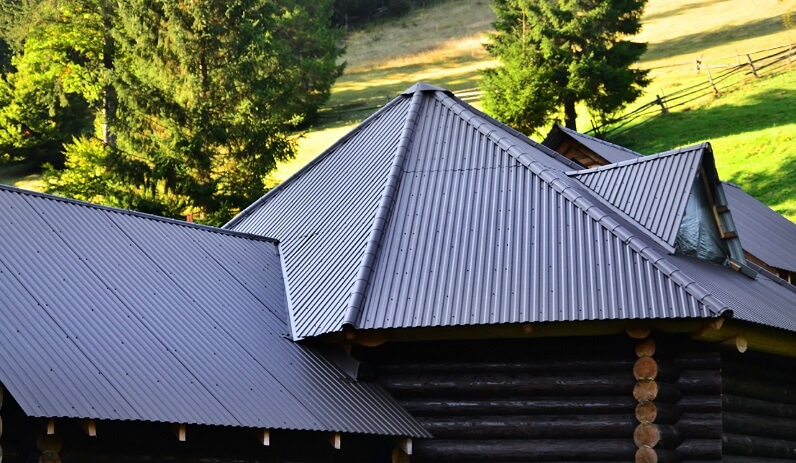
Powder Coating vs. Electrostatic Painting: What’s the Difference?
Electrostatic coating refers to electrically charging either a wet paint or dry powder, so it evenly clings to a negatively charged component. The thickness of the covering is directly related to the amount of electricity applied. Powder coating is a type of electrostatic paint.
- All dry methods require high temperatures for curing. However, it’s also available by vat dipping without an electrical charge, making this process accessible to high-temperature plastics.
- Using electricity in a wet applied paint gives the same even coating without the curing temps while allowing on-siteapplication
What Spray Paint Can Be Used on Powder-Coated Metal?
Just about any spray paint will cover powder coated metal. Priming the surface and choosing a type to match the substrate and intended use are critical. Lightly sanding it with a fine grit (120 or above) and sandblasting any rusted areas improves adhesion.
Can I Powder Paint My Car’s Rims or Wheels?
Powder coating rims and wheels is one of the most common uses in automotive customization..
Who Does Powder Coating?
Large shops that specialize in powder coating do this process since it requires specialized equipment, techniques, and training.
DIY vs. Finding a Professional
Powder coating is an exceptionally durable finish to protect anything in or around your home or business from the elements. However, the process requires sending parts to a shop or investing the money into the equipment and shop to produce products on your own. DIY solutions exist for smaller parts and hobbyists, but you need experience to get it right.
Most homeowners will require professional services. Find a professional powder coating shop near you today. Don’t forget to check reviews and always ask about warranties and guarantees on workmanship.
Powder Coat Spray Guns & Other Equipment
Powder coat guns for home use are cheap and easy to use. For small projects, you can buy starter kits with a gun and a variety of other equipment like curing ovens, compressors and other supplies for $120 to $200. These are perfect for someone doing small engine parts or hobbyist.
For large projects, professional grade machines run $500 to $5000 plus the cost of a shop and oven. Plus, you’ll need a shop and safety equipment with larger ovens. For example, doing a fence that comes in 8-foot sections requires an oven at least 8 feet long.
Ready to start your Powder Coating Project?
Find ProsReturn to Top
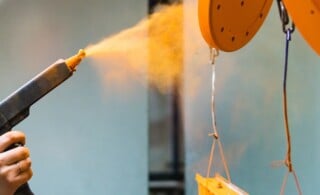 Powder Coat vs. Spray Paint: Differences in Durability, Cost & More
Powder Coat vs. Spray Paint: Differences in Durability, Cost & More  How to Fix a Leaking Fridge
How to Fix a Leaking Fridge 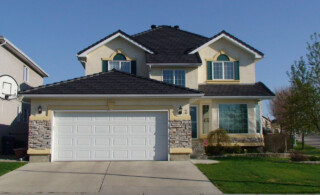 Rubber Roofing – Benefits & Alternatives
Rubber Roofing – Benefits & Alternatives  Should You Layer Shingles on Your Roof?
Should You Layer Shingles on Your Roof? 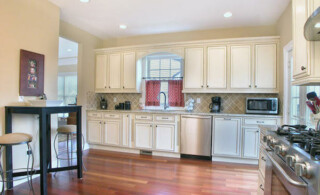 Cutting-Edge Kitchen Appliances
Cutting-Edge Kitchen Appliances 

I never knew that powder coating was extremely durable. My wife and I want to paint the awning we have in our backyard this fall, and we want to make sure the paint doesn’t just rub off during winter because of the snow. I’ll have to consider getting a professional to come powder coat our aluminum awning.